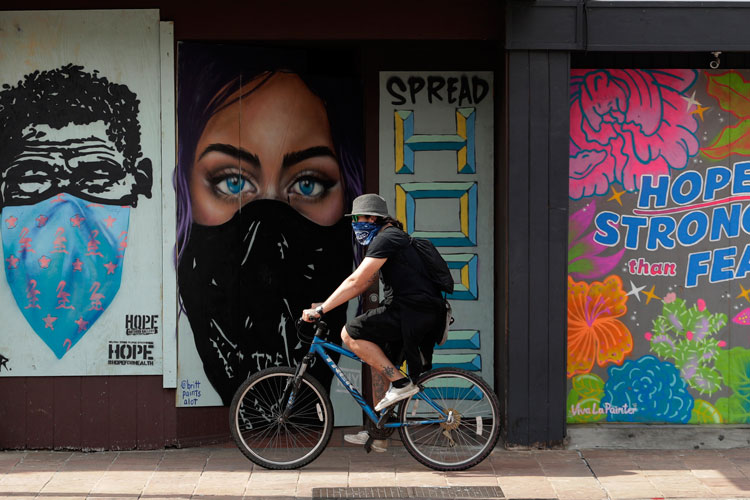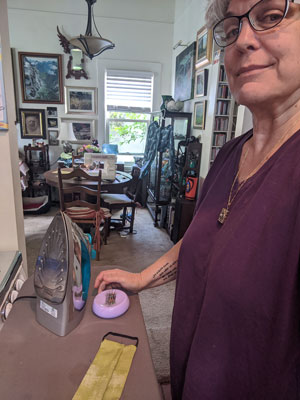Disease detective offers mask tips, hope in the face of COVID-19
Expert explains the ins and outs of face coverings in the wake of conflicting messages about masks
April 7, 2020

A cyclist wears a bandanna in downtown Austin, Texas. (AP photo by Eric Gay)
As America braces for what could be a pivotal month for combating the spread of COVID-19, the Centers for Disease Control and Prevention (CDC) has advised people to wear cloth face coverings when out in public or in proximity to others. In addition to social distancing and frequent hand-washing, facial protective gear can protect against virus transmission and shield others from a mask wearer’s possible infection. A significant number of people with the novel coronavirus have been found to lack symptoms. Meanwhile, medical grade masks such as N95 respirators — which filter out airborne particles as small as 0.3 microns — must be reserved for front-line medical workers, due to dangerously low supplies of personal protective equipment.
Even before the CDC’s advisory, Americans were making DIY masks with materials ranging from skimpy bandannas and elastic to multi-layered fabrics encasing coffee filters, vacuum bag pieces and other lightweight filtration systems. Yet, confusion abounds about what kinds of masks to wear, when and where to wear them and how best to sanitize them. At UC Berkeley, Sangwei Lu, an adjunct professor of infectious diseases and vaccinology in the School of Public Health, has studied the pros and cons of masks and other protective medical gear. She shares with Berkeley News her insights on the facial shields that can help slow the spread of COVID-19.
Berkeley News: Given the rapid spread of COVID-19, could the broader use of masks by the general public have helped sooner?

Sangwei Lu, an adjunct professor of infectious diseases and vaccinology, (Photo courtesy of Sangwei Lu)
Sangwei Lu: One could definitely argue that. Asymptomatic people and people with mild symptoms have been shown to transmit the virus. While masks may not prevent transmission completely, they should help reduce it. The ones providing the most protection are custom-fitted N95 respirator masks. So, if there were abundant supplies of N95s, everyone should be wearing them when in crowded locations and/or in close proximity to others.
However, given the current severe shortage of N95s for medical professionals, the public should not take supplies away from the medical professionals who really need them to protect both themselves and their patients. I would say, wear anything you currently have. If you don’t have any masks at all, use a bandanna, scarf or handkerchief to cover up your nose and mouth. They are not as protective as the N95s or surgical masks, but they offer some protection from respiratory droplets and prevent you from touching your face.
Can the general public reuse medical grade masks, since they are in such short supply? And if so, how do we sanitize them?
Given the shortage of all personal protective equipment (PPEs), we may all have to reuse any masks we have. Even some hospitals have to reuse masks. In fact, the CDC finally published a guideline for N95 mask reuse. It’s important for the general public to disinfect or clean masks regularly, otherwise contaminated masks worn close to the face may actually increase one’s chance of getting infected. Cloth masks can be washed and dried, so it’s a good idea to have two masks and wear them alternately.
As for non-washable masks, the CDC guidelines list several methods to sanitize, including ultra-violet light decontamination, hydrogen peroxide vapor and wet heat at 60 degrees Celsius. Heat kills viruses very effectively. Previous studies have shown that viruses, including SARS coronavirus, which is not the novel coronavirus, can be killed by a 30-minute treatment at 70 degrees Celsius or 158 degrees Fahrenheit. The CDC does not recommend dry heat, because at high temperatures such as 160 degrees Celsius or 320 degrees Fahrenheit, dry heat may damage the foam and elastic parts of N95 masks. Studies of treating N95 masks at lower temperatures are being carried out, and I look forward to seeing the results.
Note that if you wear a surgical mask, you can cover it with a cloth mask to protect it. And, to be on the cautious side, both masks should be disinfected. But it is more important to disinfect the cloth mask than the surgical mask, in my opinion, since the cloth mask is exposed to the outside environment.
What do we know about how the novel coronavirus interacts with masks upon contact?

UC Berkeley staffer Jean Smith, a member of the East Bay Heritage Quilters, sews cloth masks at her home for health care workers and other frontline personnel. (Photo by Jean Smith)
The interaction of microbes and masks falls under the field of occupational health, and I don’t think we understand it well. But from what infectious disease experts know about COVID-19 so far, it transmits through droplets in the air. So, if someone around you sneezes, the droplets can land on your mask, and the virus inside those droplets can stay alive for hours or even days. The more porous the mask, the higher the likelihood that the virus can penetrate the mask. This is why medical workers wear N95s, which allow for the least penetration. Regardless, wearing a mask is much better than not wearing a mask, because without a mask you would be breathing in the droplets directly.
People in China and other Asian countries have worn masks long before this pandemic. Could that have helped in their COVID-19 containment efforts?
Even before COVID-19, it has been culturally accepted for people in Asia to wear masks outside for their protection for any reason, mostly for diseases in the wintertime. There’s no data to say whether this helped prevent the spread of COVID-19 in Asian countries. The ability of some Asian countries in controlling the disease was due to many reasons that differ from country to country. In China, it was controlled through an iron fist — strict quarantine and isolation, emergency hospitals, free testing and treatment for all, temperature checks for all in public places, strict restrictions on movement, cell phone tracking of everyone out and about, real-time geographic information systems (GIS) tracking of cases and more. Masks are only a small part of it.
In South Korea, they ramped up testing very early on and kind of jumped in front of the moving train. It has been hugely beneficial, because South Korea is the only country that has managed to control COVID-19 without having to resort to a lockdown. And, yes, people in South Korea do wear masks.
Masks aside, are we in over our heads when it comes to controlling this pandemic?
COVID-19 is an infectious disease, and all infectious diseases can be controlled by cutting off transmission. Everyone needs to participate in the control effort to reduce its spread. The social distancing can make a big difference, and I believe masks are among the tools we have at our disposal, and we should definitely use them. I have been following the data from the end of January. No matter what country it is, the number of new cases appears to reach its peak about 10 to 14 days after social distancing is put into place. For California, I am optimistic that hopefully we are seeing the apex of the local epidemic, since we started shelter in place on March 17. There is hope.
SEE ALSO: